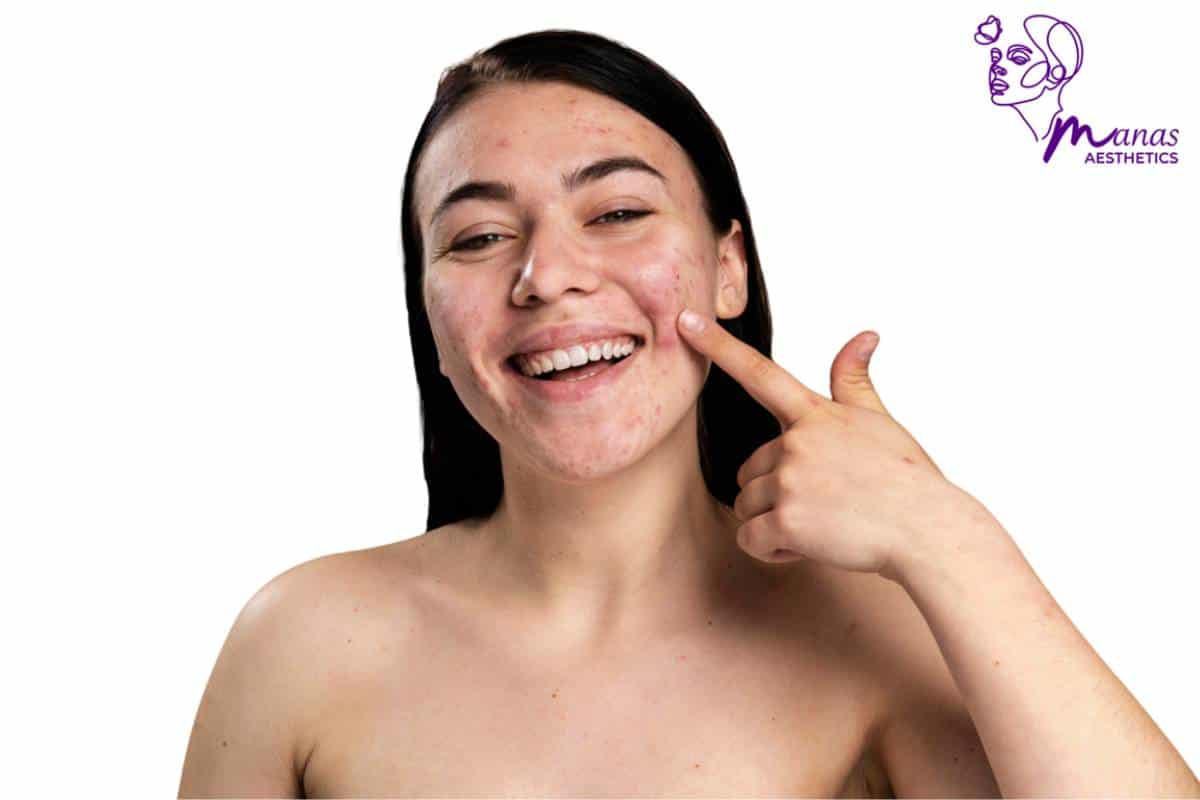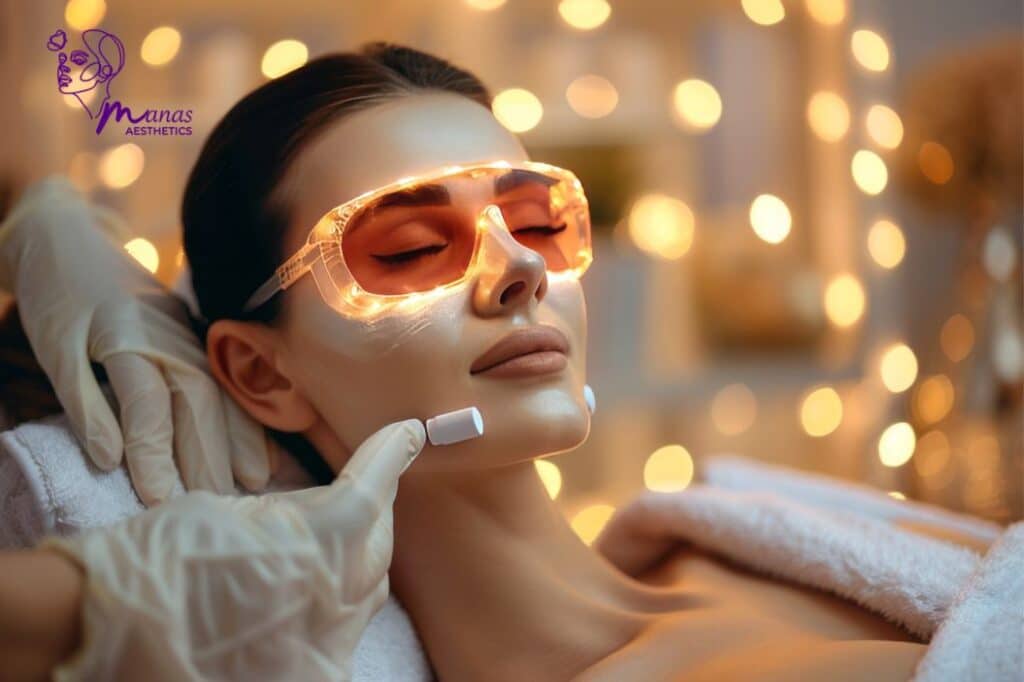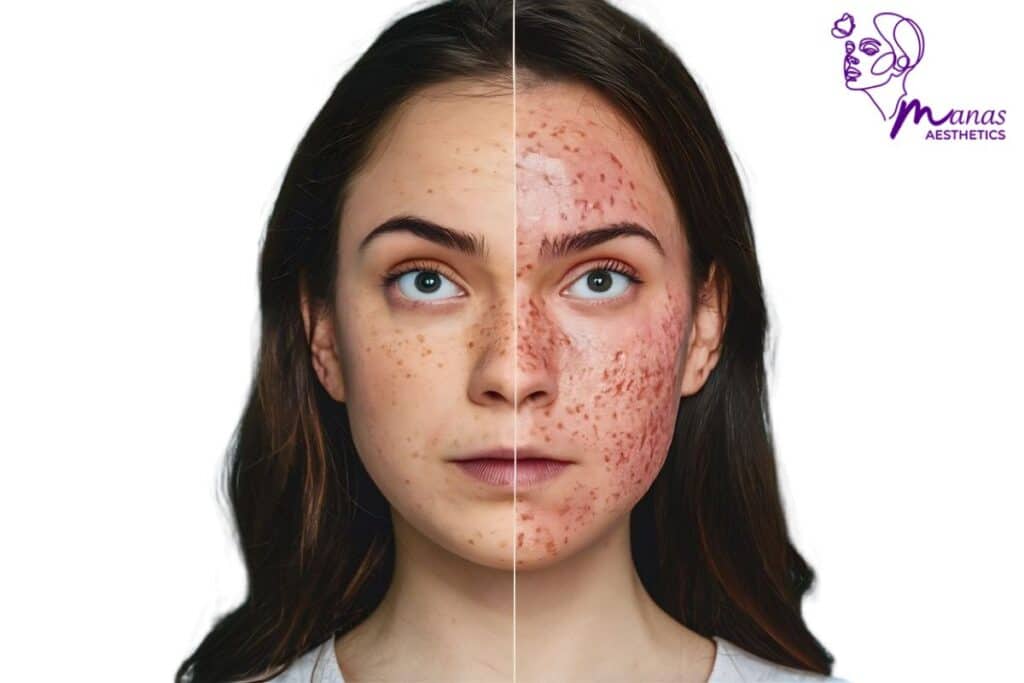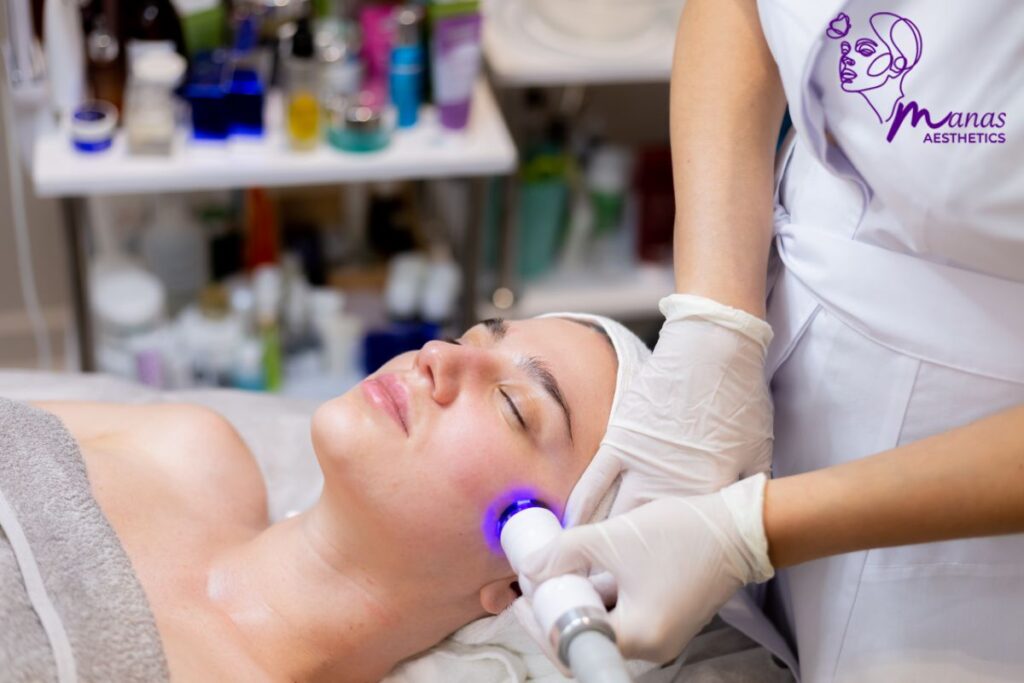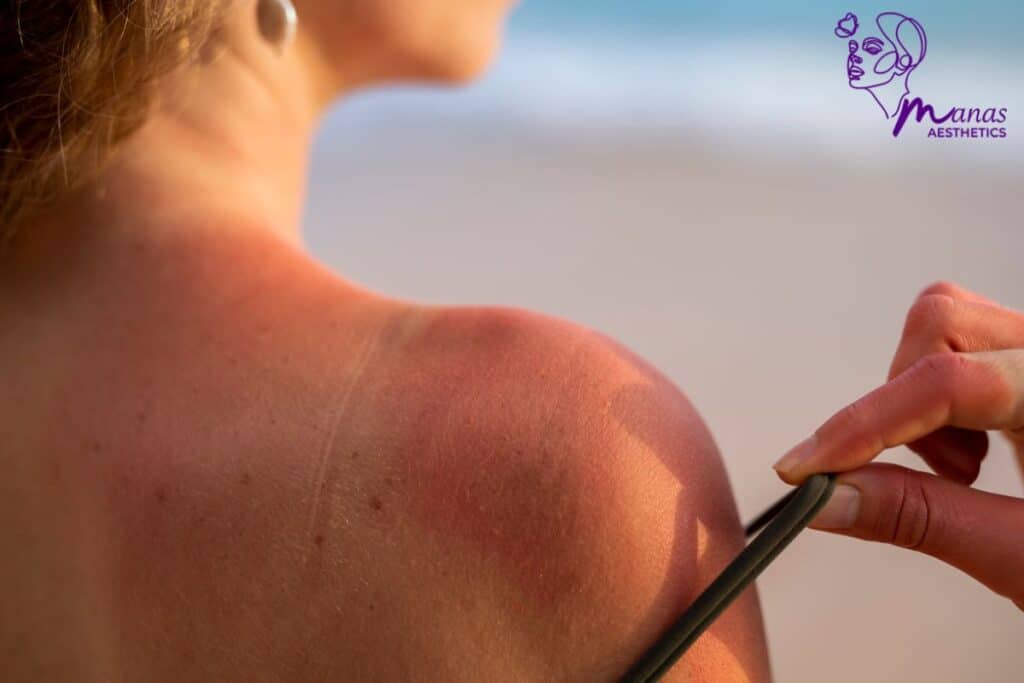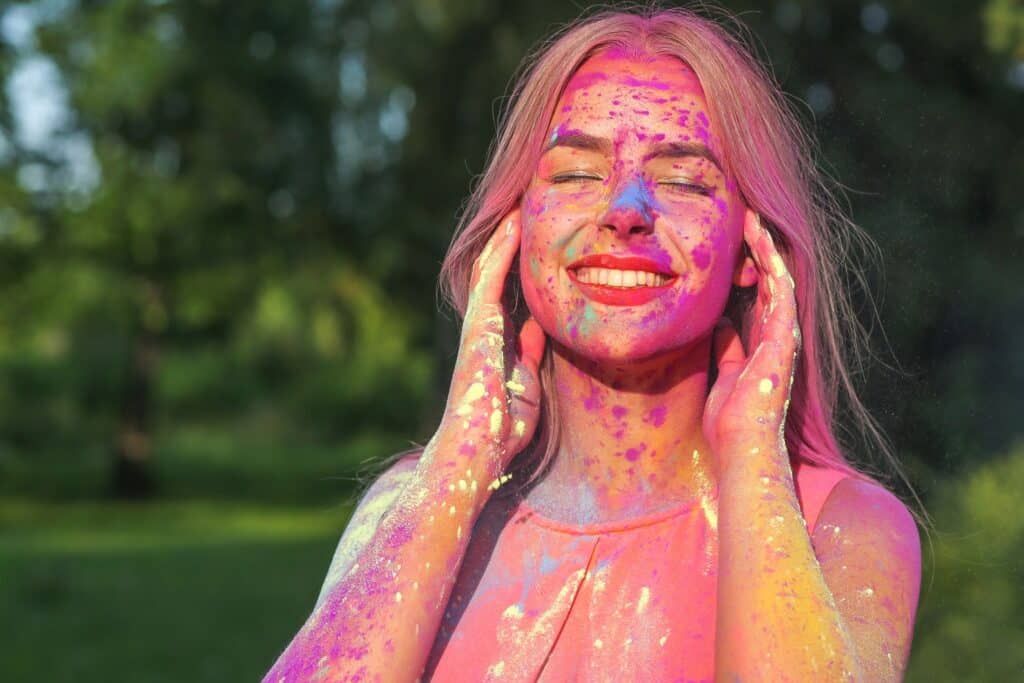Acne, a prevalent skin condition, affects individuals of all ages and genders, often intensifying during seasonal shifts such as the monsoon. This challenging time brings increased humidity and fluctuating temperatures, creating ideal conditions for acne-causing bacteria to thrive. Understanding what is acne, what are types of acne, and implementing effective acne treatments are crucial steps toward achieving clearer and healthier skin year-round. By addressing these factors proactively and getting the best acne treatment from a reputable aesthetic clinic, individuals can navigate through seasonal skin challenges with greater confidence and comfort.
What is acne?
Now, the first question arises; What is acne? Acne is a skin condition characterized by the occurrence of pimples, blackheads, whiteheads, and cysts. It typically appears on the face, neck, chest, shoulders, and back. These eruptions occur when hair follicles become clogged with oil and dead skin cells.
What are the types of acne?
Acne manifests in various forms and to know what are the types of acne one must be aware of each kind:
– Comedones: These are non-inflammatory acne lesions that include blackheads (open comedones) and whiteheads (closed comedones) caused by clogged hair follicles filled with oil and dead skin cells.
– Papules: Small, raised bumps that are typically pink and tender to the touch but do not contain pus or a visible center.
– Pustules: These are pimples with a central yellow or white spot (pus-filled head) surrounded by red, inflamed skin. They are often painful to touch.
– Nodules: Large, solid, painful lumps beneath the surface of the skin that develop deep within hair follicles. They can be stubborn and may persist for weeks or months.
– Cysts: Deep, inflamed, pus-filled lesions that are larger than pustules. Cysts are often painful, can cause scarring, and require medical attention to prevent deeper infection.
By knowing what are the types of acne one can identify the appropriate treatments from best aesthetic clinics and manage the condition effectively.

Symptoms and Causes of acne
What are the symptoms of acne?
Acne symptoms range from mild to severe and may include:
– Blackheads and whiteheads: Non-inflammatory types characterized by clogged pores.
– Inflamed papules and pustules: Raised, red bumps with or without pus.
– Painful nodules and cysts: Deep, tender lumps under the skin’s surface.
– Redness and swelling around eruptions: Inflamed areas surrounding acne lesions.
These symptoms vary in severity and appearance, impacting both physical comfort and self-esteem. Understanding these signs helps in identifying the appropriate treatments available in aesthetic clinics and managing acne effectively.
What causes acne?
Several factors contribute to the development of acne:
– Excess oil production: Hormonal changes, particularly during puberty or times of hormonal imbalance, can stimulate the sebaceous glands to produce more sebum (skin oil). This excess oil can clog hair follicles and lead to acne.
– Clogged pores: Dead skin cells and excess oil can accumulate within hair follicles, creating a plug that blocks the pore openings. This environment provides a breeding ground for acne-causing bacteria.
– Bacteria: Propionibacterium acnes (P. acnes), a type of bacteria normally present on the skin, can multiply rapidly within clogged pores. This bacterial overgrowth contributes to inflammation and the formation of acne lesions.
– Inflammation: When the follicle wall ruptures due to pressure from accumulated sebum, bacteria, and dead skin cells, the surrounding skin becomes inflamed. This inflammation causes redness, swelling, and pain associated with acne.
Understanding these underlying factors helps in adopting preventive measures and selecting effective treatments to manage acne effectively.
How is acne treated?
Effective acne treatments aim to address several key factors contributing to the condition. These acne treatments include reducing excess oil production through topical treatments like retinoids or oral medications such as isotretinoin, which regulate sebum levels. Additionally, acne treatments like salicylic acid promote skin cell turnover, preventing pore blockage by exfoliating dead skin cells. Antibacterial agents such as benzoyl peroxide or antibiotics target Propionibacterium acnes bacteria to combat infection, while anti-inflammatory medications, both topical and oral, alleviate swelling and redness around acne lesions. Some of the acne treatments include:
Topical acne medications
Topical acne treatments such as benzoyl peroxide, salicylic acid, and retinoids play pivotal roles in managing acne by addressing multiple aspects of the condition. Benzoyl peroxide functions as an antibacterial agent, effectively killing P. acnes bacteria that contribute to acne formation. It also helps to reduce excess oil production and unclog pores, preventing new breakouts.
Salicylic acid, a beta hydroxy acid (BHA), exfoliates the skin by breaking down the bonds between dead skin cells, thereby preventing pore blockage and promoting smoother skin texture.
Retinoids, derived from vitamin A, regulate skin cell turnover, avoiding the formation of comedones (blackheads and whiteheads) and encouraging the growth of healthy skin cells. Additionally, retinoids have anti-inflammatory properties, reducing redness and swelling associated with acne lesions.
Together, these topical acne treatments provide:
- A comprehensive approach to managing acne.
- Improving skin appearance.
- Preventing future outbreaks when used consistently and as directed by professional guidance.
Oral acne medications
Professionals prescribe several medications to manage acne, targeting specific causes and severity levels effectively. Antibiotics, such as tetracycline or erythromycin, are commonly prescribed to combat bacterial infections associated with acne, reducing inflammation and preventing further outbreaks.
Oral contraceptives, particularly for females experiencing hormonal acne, regulate hormone levels, specifically androgen hormones responsible for excess sebum production. This hormonal balance helps to alleviate acne symptoms over time. For severe cases of acne that do not respond to other acne treatments, isotretinoin, a powerful oral medication derived from vitamin A, is often recommended. Isotretinoin works by reducing sebum production, shrinking the sebaceous glands, and preventing acne lesions from forming.
However, due to its potent nature, isotretinoin requires careful monitoring and may have potential side effects that need to be managed under medical supervision. These medications highlight the diverse approaches professionals employ to tailor acne treatment plans to each individual’s specific needs and conditions.
Additional acne therapies
Procedures such as chemical peels, laser therapy, and photodynamic therapy serve as valuable adjuncts to traditional acne treatments, enhancing overall effectiveness, particularly for stubborn or severe cases.
Chemical peels involve the application of a chemical solution to exfoliate the skin’s outer layer, unclogging pores and promoting skin renewal.
Laser acne treatment targets and destroys P. acnes bacteria while reducing sebum production and inflammation. It also stimulates collagen production, aiding in skin healing and reducing acne scars.
Photodynamic therapy utilizes light-sensitive medications and specific wavelengths of light to kill bacteria and reduce oil production, effectively treating acne lesions and preventing future breakouts.
These procedures are often recommended when topical and oral acne treatments alone do not provide satisfactory results, offering tailored solutions to improve acne severity and restore clearer, healthier skin under the guidance of qualified professionals.
In conclusion
Embracing a proactive skincare regimen and healthy lifestyle choices can effectively minimize acne outbreaks. Consistently using gentle cleansers and non-comedogenic products, as recommended by Manas Aesthetics, the best aesthetic clinic in acne treatment in Mira Bhayandar, helps maintain clear skin. Control oil production with their specialized oil-free moisturizers and avoid touching your face excessively. Incorporate a balanced diet low in dairy and high-glycemic foods, manage stress through activities like yoga or meditation, and stay hydrated to flush out toxins. These practices, combined with Manas Aesthetics Clinic expert guidance, promote healthier skin and overall well-being.

